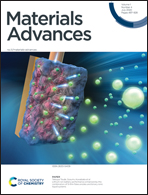A yolk–albumen–shell structure of mixed Ni–Co oxide with an ultrathin carbon shell for high-sensitivity glucose sensors†
Abstract
Non-enzymatic glucose sensors based on different Co–Ni–C composite materials were developed by pyrolysis of bimetallic or single metal based metal–organic frameworks (MOFs). The structure and composition of the resulting materials were explored by XRD, nitrogen adsorption/desorption isotherms, SEM, HRTEM and STEM-EELS. The electrochemical performance of the bimetallic MOF derived novel yolk–albumen–shell structure of Ni–Co@C (YASNiCo@C) stands out from these materials. The YASNiCo@C electrode exhibited a sensitivity of 1964 μA cm−2 mM−1 with the detection limit of 0.75 μM, a linear range from 5 μM to 1000 μM and good stability for the detection of glucose. These promising electrochemical performances prove that YASNiCo@C is a promising material for glucose sensors. Moreover, the strategy outlined in this work for the design of MOF based nanomaterials can also be used beyond glucose sensors.



 Please wait while we load your content...
Please wait while we load your content...